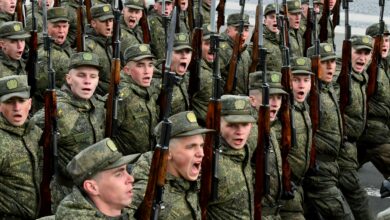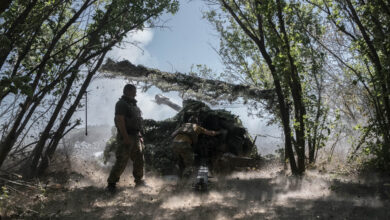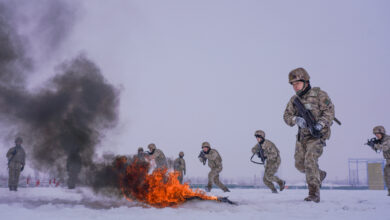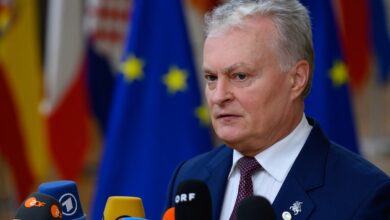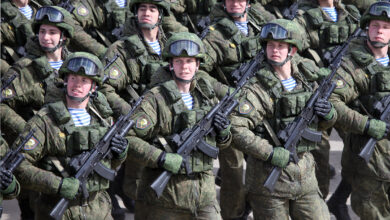Did the Kremlin influence Trump’s plan to withdraw from Syria?
French President Emmanuel Macron has evidently persuaded Donald Trump to leave U.S. forces in Syria beyond the fight against Islamic State. After their meeting at the White House last Tuesday, President Trump said he would still “love to get out” of Syria, but neither he nor Macron “want to give Iran open season to the Mediterranean.” Aligning once again with his State and Defense Departments, Trump affirmed, “We want to leave a strong and lasting footprint.”
But as of yet there has been no explanation for the president’s abrupt decision to go rogue against his own administration in the first place. Trump’s first public remark that the U.S. would withdraw from Syria after routing ISIS was made alongside Australian Prime Minister Alastair Campbell in a February 23 press conference.
The statement is said to have jarred the Washington national security establishment because, until then, the administration’s official policy had been to sustain its troop presence in Syria to prevent Islamic State’s return and, though they have seldom admitted it, block Iranian regional ambitions and pressure Bashar al-Assad to accept U.N.-monitored elections.

Legally speaking, the president was right. The current U.S. military intervention in Syria is illegal under international law, and any straying of Operation Inherent Resolve from the drive to defeat ISIS – including hedging Iran and coercing the Assad regime – would exceed the mission’s already feeble legal grounds under the 2001 Authorization of the Use of Military Force. True, legality may be a rare concern for this president, but his aversion to drawn-out foreign conflicts is well known.
But why so doggedly undercut his own administration in public for over a month? And why protest then, several weeks after he had reportedly approved Rex Tillerson’s declaration at Stanford University that the U.S. would remain in Syria and demand Assad’s departure?
It may have been no more than a flip of the president’s temperament, but the timing is particularly interesting. According to AP, Trump first began telling senior White House aides that he wanted out of Syria back in mid-February – that is, just days after U.S. troops near Deir Ezzor came under coordinated assault by hundreds of Russian mercenaries, Syrian army elements, and Iran-backed militia fighters attempting to seize one of the country’s largest natural gas fields.
As I wrote in The Defense Post last month, the Pentagon has been deliberately concealing key details of the Conoco incident, probably because defending captured Syrian gas and oilfields from Damascus is not legal under the administration’s interpretation of the 2001 AUMF.
U.S. Special Operations Forces and their Kurdish and Arab allies outmaneuvered a combined pro-regime force to seize that massive gas field from ISIS back in September. The move angered the Syrian regime and Russian Ministry of Defence, triggering a hostile standoff over the site complete with mutual accusations and intermittent fire exchanges through the four months leading up to the February 7 assault. Major combat between the two sides broke out again on Sunday near the Conoco field, but the Pentagon still refuses to acknowledge why.
The Vietnam meeting
Presidents Trump and Putin appear to have discussed the ongoing standoff when they met on the sidelines of the Asia-Pacific Economic Cooperation summit in Vietnam on November 10 and 11, and their encounter is worth revisiting.
The Kremlin had been pushing for a formal sit-down meeting between the pair in the lead-up to the conference, but Trump’s team resisted, citing scheduling conflicts and questioning whether there was anything substantial to discuss. Putin’s foreign affairs advisor Yuri Ushakov had asserted that there was.
“One way or another, the meeting will take place on the sidelines,” Kremlin spokesperson Dmitry Peskov told reporters. It did, and at the last minute, Washington’s press pool was inexplicably barred from entering the events, reportedly by the summit’s organizers. Russian media later gratefully credited Vietnamese organizers with placing Trump and Putin next to each other for the photo op.

Though Foreign Minister Sergey Lavrov expressed annoyance at the lack of a formal meeting, the Russian president seems to have gotten a message across. Trump told reporters aboard Air Force One later that day that “during those conversations, we talked about Syria and de-conflicting, etc. You know, we have areas where troops are facing – our troops – I mean, their troops are facing our troops and there’s nothing in between.” The area near the Conoco gas field was then the only site in Syria where the two sides were contesting territory on the Coalition’s side of the Euphrates River.
Trump claimed that the pair had made a deal on Syria “very quickly” that would save “tremendous numbers of lives.” It is entirely unclear what they agreed upon, but the joint statement expressed “their satisfaction with successful U.S.-Russia enhanced de-confliction efforts” between their forces. There are no credible reports of changes in battlefield positions in that area following that meeting, and the U.S. and its allies maintained their control over the local petroleum and gas fields, which contain a majority of Syria’s known reserves.
Because the ongoing stalemate on the east side of the Euphrates near the Conoco gas field had not yet been reported in the media at the time, Trump instead made headlines that day for saying he believed Putin’s denials of Russian interference in the 2016 U.S. elections. But he also uttered something more ominous: that the Mueller investigation was preventing him from “solving problems with Russia” on Syria.
The president clearly stated that Putin had told him this directly. Trump then suggested that if the special counsel’s investigation could be done away with, he could convince Russia to “pull back from Syria” and elsewhere. At the time, the president said he would ideally like to see a full Russian withdrawal from Syria, not American.
“We can save many, many, many lives by making a deal with Russia having to do with Syria … Having a good relationship with Russia is a great, great thing,” Trump said. “And this artificial Democratic hit job gets in the way, and that’s a shame, because people will die because of it.”
Nine days later, Putin met with Assad in Sochi, then the next day spoke with Trump on the phone about Syria and other matters for “over an hour.”
The Conoco Incident
Trump’s words in Vietnam might have been bluster, but within days of his discussion with Putin, Russian aircraft were violating Coalition-controlled airspace over Deir Ezzor’s oil region daily, and continued to do so for several weeks, ostensibly to test the American response. During the first week in February, Coalition forces around the Conoco gas field began observing pro-regime troops mobilizing to their south.
Among those troops, it was later revealed, were Russian paramilitary contractors from the Wagner group, which operates as an unofficial arm of the Russian Ministry of Defence and is believed to be controlled by Yevgeniy Prigozhin, a shady fixer for Putin. As has been widely reported, Prigozhin also holds a lucrative contract with the Syrian Petroleum Ministry that grants his Moscow-based shell company, Evro-Polis, 25 percent of proceeds from all Syrian oil and gas fields in exchange for their recapture on behalf of Damascus.
 On January 24, according to The Washington Post, U.S. intelligence officials intercepted communications in which Prigozhin informed a Syrian Presidential Affairs Minister Mansour Fadlallah Azzam that Prigozhin had received permission from an unidentified Russian minister to launch the what was to be the Conoco assault. Azzam reportedly assured his Russian contact he would be financially rewarded. On January 28, perhaps by chance, the U.S. Treasury Department designated Prigozhin for sanctions over his deal with the Syrian Petroleum Ministry. He is also a subject of the Mueller investigation for financing the Russian internet disinformation campaign to support Trump’s presidential candidacy, and was indicted in mid-February.
On January 24, according to The Washington Post, U.S. intelligence officials intercepted communications in which Prigozhin informed a Syrian Presidential Affairs Minister Mansour Fadlallah Azzam that Prigozhin had received permission from an unidentified Russian minister to launch the what was to be the Conoco assault. Azzam reportedly assured his Russian contact he would be financially rewarded. On January 28, perhaps by chance, the U.S. Treasury Department designated Prigozhin for sanctions over his deal with the Syrian Petroleum Ministry. He is also a subject of the Mueller investigation for financing the Russian internet disinformation campaign to support Trump’s presidential candidacy, and was indicted in mid-February.
It is unclear whether Putin had foreknowledge of the assault, though Prigozhin was reportedly in increased contact with the Russian president’s chief of staff Anton Vaino and the deputy chief of staff in the preceding and following days. Moscow would have likely learned of the operation’s failure in the early morning hours of Thursday, February 8. That weekend, following the crash of Saratov Airlines flight 703 near Moscow, Putin cancelled and rescheduled a number of appearances planned for the upcoming week, including a campaign trip to southern Russia for February 12 and 13. Peskov cited everything from the plane crash to scheduling conflicts to Putin’s head cold.
On February 12, Putin and Trump spoke on the phone. A source close to the Russian Ministry of Defence told the BBC that Putin then held a private meeting with top generals in Moscow on the following day. Around that time, Trump began telling White House personnel that he wanted to pull out of Syria.
It’s probably a coincidence. But it might not be.



